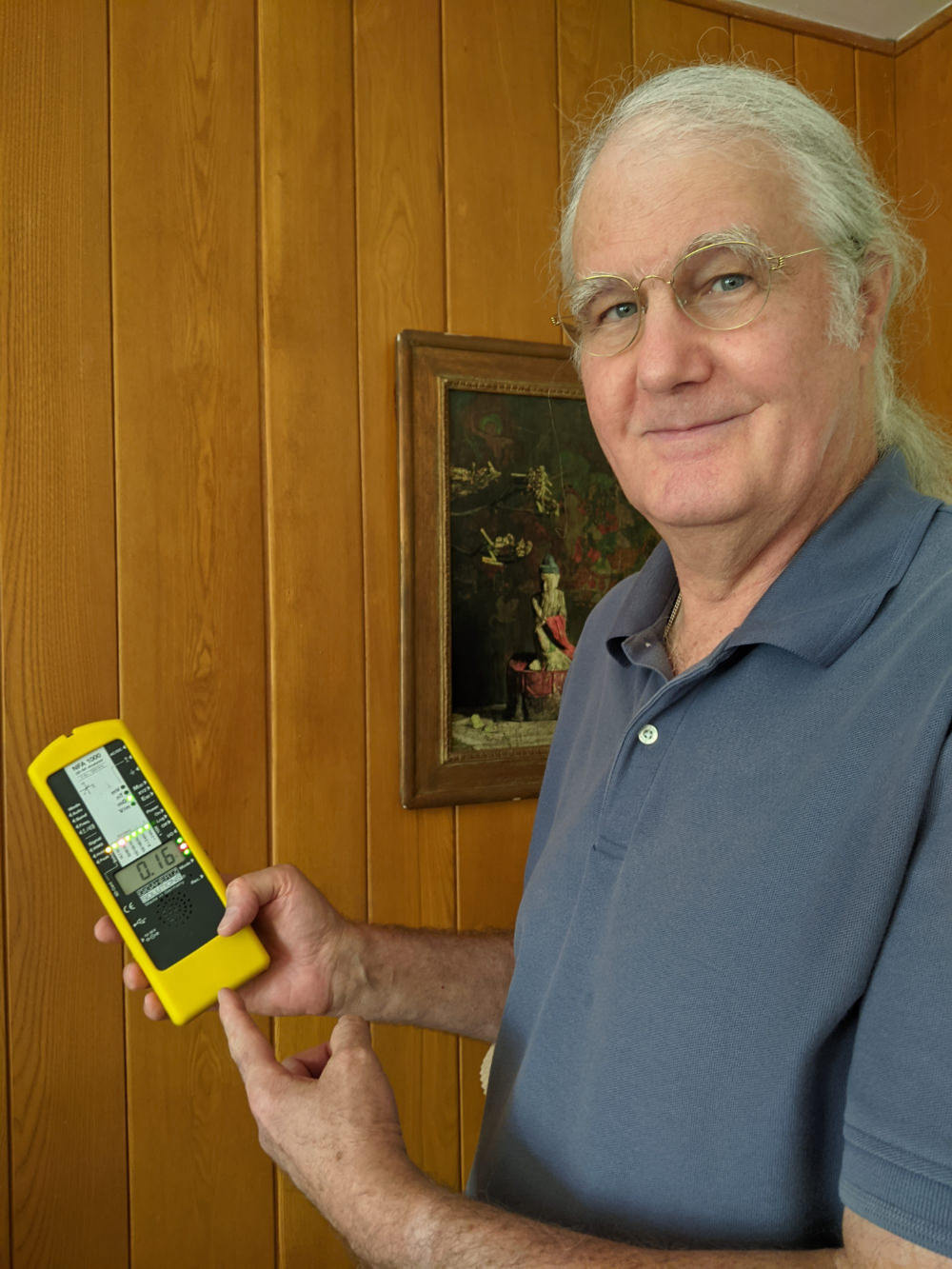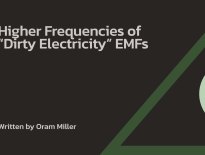Many clients ask if there are potentially unhealthy EMFs in their kitchens and laundry rooms, especially if they are building a new home or remodeling an existing one and need to purchase new appliances.
Kitchen Appliances
Starting with a gas stove or electric range, I have been telling clients that if EMFs are their primary concern and they are not overly chemically sensitive, they should choose a gas stove rather than an electric range. Of course, there is recent concern about by-products of the burning of fossil fuels (natural gas) in indoor environments. Gas stoves can also have a digital clock in the front where your abdomen would be located when you stand to cook, even if there is no clock or any evidence of electronic controls.
Any time you see a digital LCD or LED clock on either an electric range or a gas stove, there is likely to be a wire-wound transformer behind it. This type of transformer produces a strong, but compact magnetic field, sometimes exceeding 10 milliGauss (mG). Being a point source of magnetic field exposure, that field strength drops off exponentially, meaning 90% of the decline occurs in the first one foot or so. Beyond that, the remaining 10% tapers off over the next one to two feet.
Generally I find that the safe distance from such a transformer is wherever a Gauss meter reads below 1.0 mG, which is usually about 3 feet. For an electrically sensitive person, that level should be below 0.5 mG or even less, depending upon the ambient magnetic field level in the room. Every electrically sensitive person should own a three-axis Gauss meter. A good, inexpensive three-axis Gauss meter is part of the new digital Tri-Field TF2 combination meter, available from LessEMF here. Other Gauss meter choices are available here.
If you have a single axis Gauss meter, you must position the Gauss meter in three orientations (X, Y and Z axes) wherever you are measuring to make sure you catch the orientation of the magnetic field with the highest reading. Then, hold the meter in that orientation and move it away from the location with the highest magnetic field reading until you find the safe distance. Then, stand outside that circle, where the reading is less than 1 mG.
As mentioned above, I have seen gas stoves with no digital clock and no electronic controls that still had a magnetic field at the front panel where the mechanical gas knobs were located. You must measure all ranges and stoves, electric or gas, with a Gauss meter, slowly sweeping the meter across the front of the range or stove where your abdomen would be, from left to right to see if a hidden transformer exists. If so, then determine the safe distance and always stand back of that circle.
Ideally, choose a model of stove or range with the clock and electronic controls at the back or side, not the front. You should measure no magnetic field at the front. However, if your stove or range does have it’s clock and electronic controls at the front, that is not always an indication that a wire-wound transformer is right behind it. I have measured no increase in magnetic field level in front of some digital clocks, meaning, that stove’s wire-wound transformer is located somewhere inside, or the manufacturer is using a switch mode power supply to transform the voltage from 120 Volts down to low voltage to run the circuit board for the controls, rather than using a wire-wound transformer. Switch mode power supplies do not produce magnetic fields at all the way wire-would transformers do (but they do produce dirty electricity, which wire-would transformers do not). You always have to measure the magnetic field level to be sure.
You can see a video of me showing how to properly measure magnetic fields (using a single axis Cornet ED88T Plus combination meter) by clicking here and scrolling down along the right side to the video link below the Cornet meter.
Turning to another source of magnetic field EMFs from an electric range, there will be a point source of magnetic field exposure from a front burner when it is on for cooking. These burners turn on for roughly 10 seconds, and then off for roughly 10 seconds to hold the temperature you have dialed in with the control (low, medium, high). The magnetic field occurs when the electric heating coil/burner is actually on. The field extends out from the coil roughly 2 to 3 feet. Once again, you have to measure with a Gauss meter to find the safe distance (below 1.0 mG) when either front burner is on. Some electrically sensitive clients are forced to only use back burners on their electric range to avoid the magnetic field caused by any burner when it is on, which usually dissipates from a back burner before it reaches the front of the stove. Or, they stand to one side when using a front burner.
Regarding ovens with an electric heating element, when they are turned on, there will be a large magnetic field coming out from the front of the oven at calf level (if the oven is in the lower portion of a standalone range or stove). Measure this with your Gauss meter to determine the safe distance. You could have this magnetic field even if you are cooking on a stove-top burner with a gas flame if the oven is electric and it is on.
Induction Cooktops
Induction cooktops are a different story altogether. They are designed to heat up a metallic pan or skillet by alternating the orientation of electrons in the metal by producing and reversing the polarity of a magnetic field at high speed. The magnetic field that is created is, of course, not confined to the one or so inch around the burner that the metal cookware is sitting upon. I have measured magnetic fields at levels we consider to be unhealthy (more than 5-10 mG) several feet away from an induction cooktop when on. One model filled half the kitchen with unhealthy levels of magnetic field exposure. I suggest to my clients that they forego induction cooktops in favor of a gas stove, or an electronic range using the precautions mentioned above (cooking on back burners if you are electrically sensitive).
However, there are several induction cooktop models that do not produce high levels of magnetic fields. One manufacturer is Gaggenau, at least the models I have tested. If you have chosen a Gaggenau induction cooktop, the specific model would need to be assessed at a showroom for magnetic fields. I have also measured a Bosch induction cooktop that emitted magnetic fields similar to what I find with traditional electric cooktops when cooking, but not higher. The same is true for an Aga induction cooktop, imported from England, specifically the Elise model. It was checked in a showroom by a client of mine with his AlphaLabs UHS2 three-axis Gaussmeter and found not to be any different than a standard electric cooktop stove with magnetic fields only extending out about two feet from each burner when in use, which is common to all electric cooktops.
You would therefore want to use the back burners on a Gaggenau, Bosch or Aga induction cooktop (as you would with any electric range) if you are trying to avoid magnetic fields where you stand when you cook, but doing so would allow you to an induction cooktop (at least the makes and models we tested).
Other brands and models of induction cooktop stoves can produce exceedingly high magnetic fields. Each brand and model that you consider purchasing needs to be checked in a show room before purchase, as even Bosch, Gaggenau and Aga may change future models so that they emit high magnetic fields like other brands of induction cooktops do.
Microwave Ovens
Microwave ovens are a source of magnetic fields in two ways. First, the digital clock and electronic control circuitry needs a transformer, which is often located right behind the clock. If it is a wire-wound transformer, this creates a magnetic field that can extend 2-3 feet out from the front of the microwave oven 24/7, often at head level. Many clients who don’t use their microwave oven will unplug it if they have access to the plug, or flip off the breaker for it’s outlet (which is usually dedicated, with no other outlet on that mircrowave circuit).
When running, a microwave oven will produce exceedingly high magnetic fields that can extend 10 feet or more in all directions. Besides devitalizing essential life energy of the food you are cooking inside of it, according to some reports, microwave ovens also produce a large magnetic field in your kitchen when running.
Furthermore, microwave ovens also produce high levels of radio frequency (RF) EMFs at 2.4 GHz, the frequency of WiFi. This is the frequency that heats up water in vegetables, which is how it cooks. The seal around the door of most microwave ovens does not always hold up, allowing RF to often leak into the kitchen when the microwave is running (the sides, top and bottom and the glass in it’s small window are supposed to be shielded, but they often also allow high RF levels to escape the microwave oven when on). I customarily measure very high and unhealthy radio frequency EMF levels in a kitchen when the microwave is turned on, often in the thousands of microWatts/meter squared, even six or more feet away. We recommend that clients stand across the kitchen when using it (or forego the microwave altogether and instead cook their food and heat their water in a pan or kettle on a stove top burner or cook in a countertop convection oven).
Dishwashers
Regarding dishwashers, you should also measure the front of your dishwasher for the presence of magnetic fields because manufacturers often put a wire-wound transformer in the lid where electronic controls are located. Watch out for this and if present, determine the safe distance to stay away from the dishwasher if you stand in front of it to do food prep on the countertop above. Most dishwashers do not have a transformer in the lid, but they are becoming more common. If the model uses a switch mode power supply, you will not measure a magnetic field.
Of course, when any dishwasher is running, it will have a high magnetic field from the motor, and also from the heater coil during the drying phase. Don’t stand or sit near any dishwasher when it is running.
When you purchase a new dishwasher, you can not measure magnetic fields in the showroom, as most models are stored in a warehouse, wrapped in plastic. You often don’t learn whether your dishwasher has a transformer in it’s lid until it is installed. For this reason, we often suggest that homeowners have an electrician install a shut off switch under the kitchen sink or on the back splash on the counter above the dishwasher in new construction and remodeling. This switch would control the outlet that the dishwasher is plugged into. Keep it off except when running the dishwasher and you won’t have this magnetic field at your abdomen when you stand close to it’s front to do food prep. You can also use a portable remote outlet plug-in switch that is rated to handle the current load for the heating element in the dishwasher when it is in the drying mode to turn off the power to the dishwasher when it is not running, which eliminates the magnetic field at the lid.
Watching for a magnetic field in the front of a range, stove or dishwasher is especially important for anyone who is pregnant. The developing fetus must not spend time in a high magnetic field while mom cooks at the range or stove.
To finish our review of the kitchen, the biggest source of magnetic field EMFs in any kitchen is the compressor motor of the refrigerator. That field often extends in all directions a good 3-4 feet, and sometimes farther, but only when it is running. When it is not running, there is no significant magnetic field. This field usually does not reach the front of the refrigerator where you would stand to get food, but occasionally the field can extend beyond the front when running. You just have to measure. The field will, of course, extend to the sides and back, so do not stand and do food prep right next to a refrigerator.
We tell our clients to always see what is on the other side of a refrigerator or freezer. There should be no beds, couches, chairs or desks behind a refrigerator or freezer. Otherwise, you or your family could be sitting or sleeping in a large magnetic field every 20 minutes or so as the compressor motor comes on and off. Measure with your Gauss meter to determine the safe distance.
Laundry Appliances
Turning to the laundry, both your washing machine and dryer will produce a magnetic field when the motor is running. However, when you are not washing or drying a load of laundry, there will be no significant magnetic field. That occurs only when the appliances are in use. The magnetic field will extend through the wall when either the washer or dryer motor is running, so make sure a bed, desk, couch or chair is not located on the other side of the wall from these appliances, or, do not do laundry when you sleep (if a bed is on the other side of the wall).
Also, make sure your electric washer or dryer has a four-wire AC power cord and plug and that the outlet is also wired with a four-wire cable (hot wire, hot wire, neutral wire and separate ground wire). You can pull the plug out of the outlet to see if it has three or four prongs.
If the dryer plug is four-pronged, which is what we want, an electric dryer can still have a strip of metal or wire bonding the neutral wire to the ground where the power cord attaches to the back of the dryer. This is an example of a so-called “neutral-to-ground” wiring error. An electrician can pull the dryer out, take off the back cover, and remove this strap or wire. All new dryers come with four-wire cables, but the strap or wire will be present. When the metal strap is connected, electric current will flow onto the ground wires of the house’s electrical system and from there, potentially onto some of the metal water pipes, gas lines, air ducts, and conduits in the house, which can cause magnetic fields.
Also, if you still only have a three-wire cable between the breaker panel and the laundry room electric outlet (hot wire, hot wire, combined neutral/ground wire), then you will need to discuss with an electrician the possibility of replacing the three-wire cable with a proper, code-compliant four wire cable containing a separate dedicated ground wire. This would likely involve opening up walls and can be costly, so before undertaking such a project, have a building biologist/EMF consultant and electrician evaluate whether this is necessary. Magnetic fields would be confined only to times when the dryer is running.
“Smart” Appliances with WiFi and Bluetooth
Finally, many new appliances now contain a WiFi or Bluetooth transmitter and receiver to participate in a new “smart home” as part of the emerging IoT, or “Internet of Things”. This WiFi or Bluetooth transmitter allows you to monitor the functioning of your appliance using an App on your smart phone, tablet or computer.
It also allows the electric utility to monitor appliance electrical usage through their smart meters in homes where the Home Area Network, or HAN, has been set up. That has not yet happened in all electric utility service areas that I am aware of, including Los Angeles Department of Water & Power and Southern California Edison where I work. However, appliance manufacturers are now making and selling appliances that are compatible with HANs as part of the coming smart home network. Even if your smart meter does not yet have a Home Area Network set up, these new appliances can talk to your smart phone and tablet.
We have been successful at shutting off WiFi on some smart refrigerators, but not all. However, electrically sensitive people should avoid appliances with WiFi built in, which often have WiFi transmitters that cannot be shut off.
The strength of the RF signal from such transmitters in smart refrigerators, stoves, washers, and dryers is generally low and intermittent and does not exceed the levels coming out of your cell phone, tablet, router, laptop, printer, cordless phone handset and base unit, cordless mouse and keyboard, thermostat, smart TV device, and the myriad other wireless devices many readers of this website already have in their homes and pockets now. Those devices, unbeknownst to most people, emit RF signals that are far stronger than the signals I measure coming from smart kitchen and laundry appliances. That does not mean that wireless transmitters, including smart appliances, are safe. I am just pointing out that many of my clients and readers of this website tend to focus on one RF source that they read about on other EMF websites, and they are therefore completely unaware of the signals they are exposing themselves to from the dozen or so other wireless devices that are silently emitting RF signals on a regular basis within inches of their body, around the clock.
That is no one’s fault. We, as building biologists and EMF consultants, make a point of showing our clients the full range of RF exposure when we do our home EMF evaluations. As you choose your kitchen and laundry appliances carefully to avoid RF exposure, take the same time to also choose hardwired alternatives for computers, telephones, TVs, thermostats, music speakers, baby monitors, security systems and surveillance cameras used by you and your family. This is all covered in my articles Safer Use of Computers, Safer Use of Cell Phones and Radio Frequency EMFs.
If you are electrically hypersensitive, or EHS, you know all of this already and generally will not have such devices in your home in the first place. For you, you need to ask the retailer for appliances that are not “smart” and therefore do not have WiFi or Bluetooth transmitters. The sales person should know that, although, often they do not. They may have to contact the manufacture for you.

BBEC, EMRS, Certified Building Biology™ Environmental Consultant and Electromagnetic Radiation Specialist and Healthy New Building and Remodeling Consultant. Providing On-Site EMF Evaluations for Existing and New Homes and Offices in Los Angeles, Orange, Ventura, Riverside and San Diego Counties and Nationwide by Telephone and Skype. Based upon the principles of Building Biology™.






